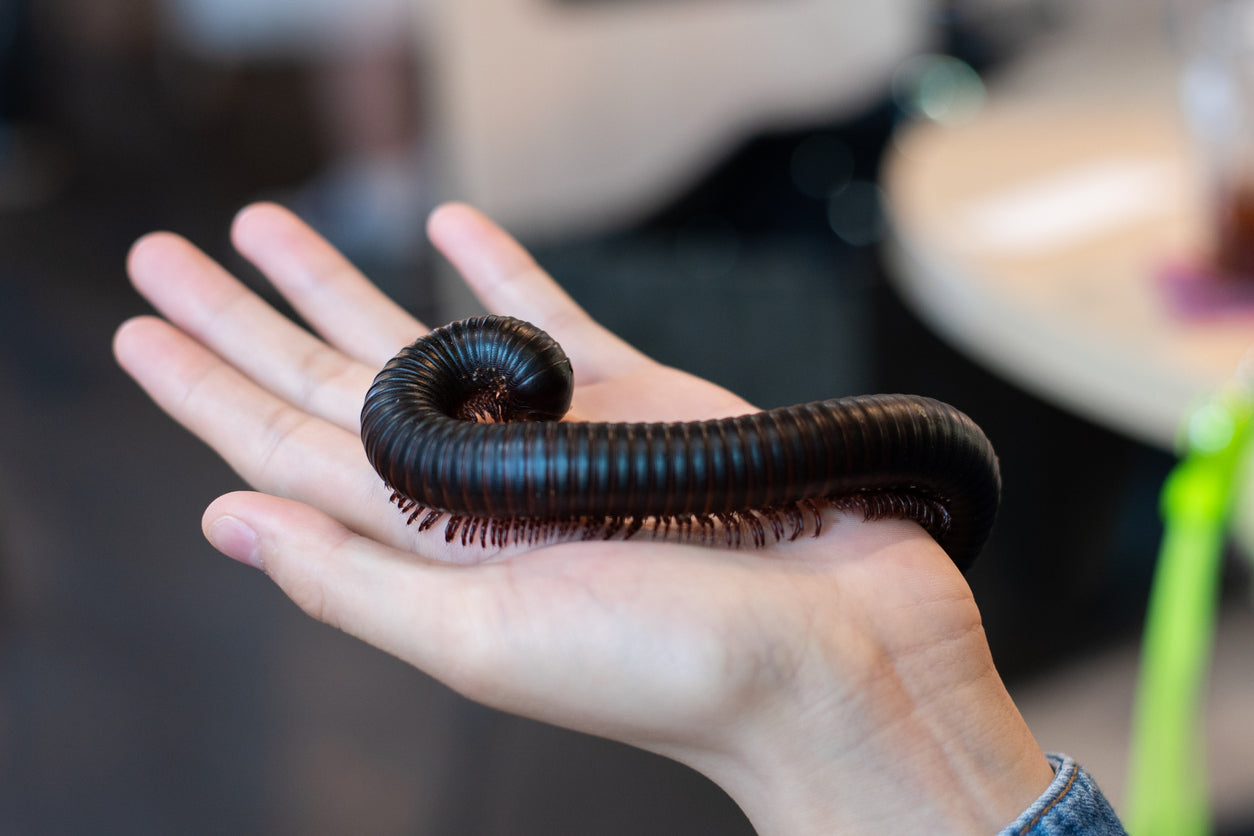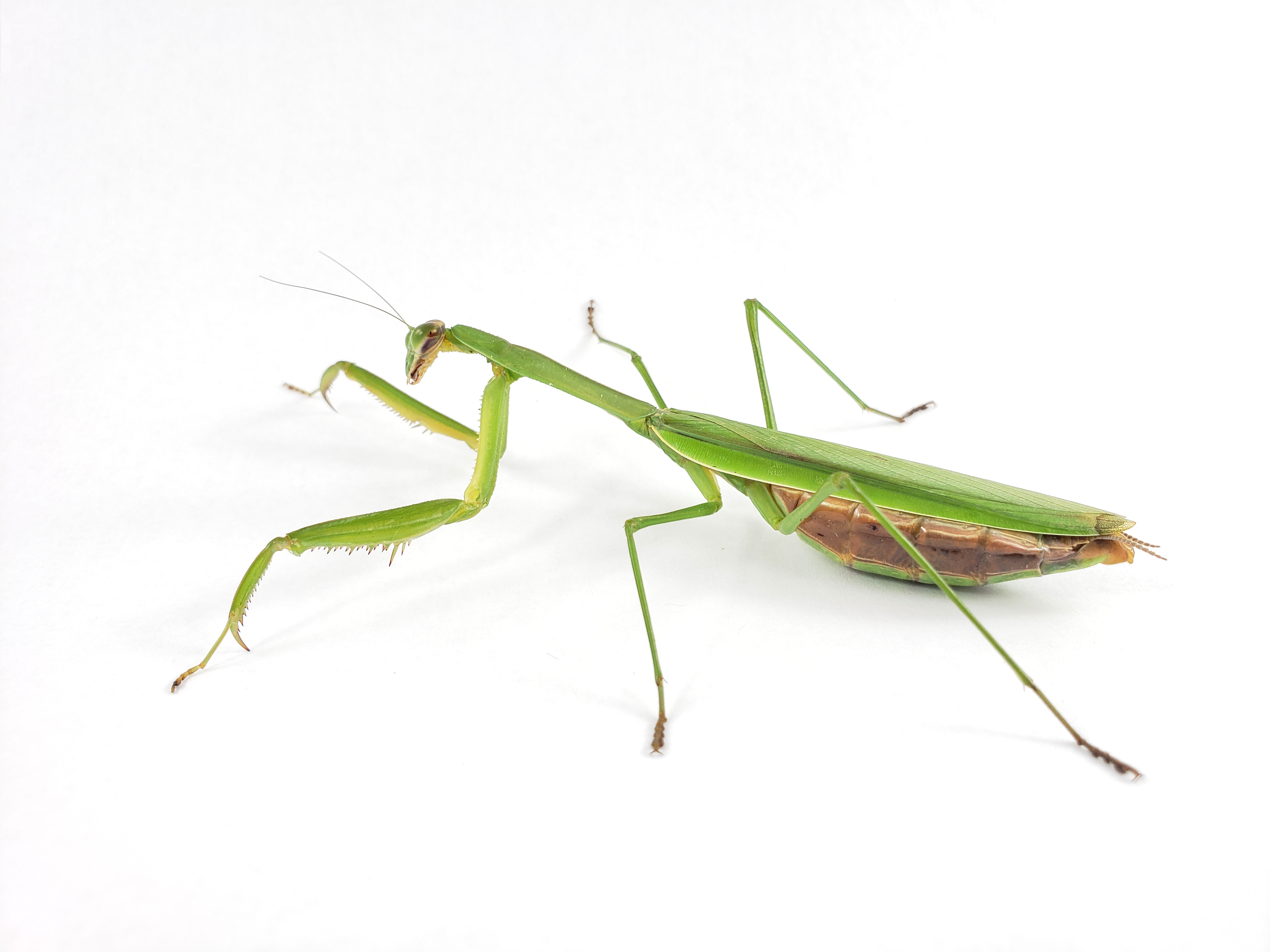The African giant millipede (Archispirostreptus gigas) is a large, nocturnal, terrestrial invertebrate found in the tropical forests of east Africa. Their preferred habitat is the forest floor, where they spend their time among the leaf litter, decaying wood, rotting fruit, and other organic debris.
African giant millipedes are typically 10-14” long, with females being larger. Although not very colorful, their length alone makes them quite impressive. The body is typically black-brown and segmented, with a set of antennae and simple eyes on the head, with at least 200-250 tiny legs on the underside of the body.
African giant millipedes are popular invertebrate pets by virtue of their impressive size. Although easy enough to care for to be beginner-level invertebrates, they still have specific needs. When cared for properly, they can live 7-10 years.
How much space do African giant millipedes need?
The minimum for appropriately keeping one adult African giant millipede is 36”L x 18”W x 18”H, or the equivalent of a “breeder” style 40-gallon tank. As foragers, they’re fairly active for invertebrates, so they will definitely use the space, and larger is likely to be beneficial.
Whatever you use for housing your millipede, don’t forget to secure the enclosure well against escape! Millipedes are surprisingly strong and adept at escaping from their enclosures when given the opportunity. Using a front-opening terrarium rather than a top-opening aquarium is a good way to guard against this problem.
Cohabitation (keeping multiple millipedes in one enclosure) is possible, but not recommended if you don’t plan on breeding them.
Do African giant millipedes need special lighting?
No, they do not.
However, if you want to use live plants as part of the decor, you will need 6500K lighting to help keep them alive. Lights should be on for 12 hours/day, and there should still be plenty of shade/cover for your millipede to hide under during the day.
What temperatures do African giant millipedes need?
Millipedes are ectotherms, which means that they need to be kept within a specific range of temperatures in order to regulate their metabolism and stay healthy.
The optimal ambient temperature for giant millipedes around 75°F during the day. As this is generally slightly warmer than average room temperature, use a low-wattage ceramic heat emitter or radiant heat panel to maintain air temps within the ideal range. Alternatively, you can stick a heat mat to the long side of the enclosure. All of these options must be regulated by a thermostat for consistent results.
It’s a good idea to track the temperatures in your enclosure with a digital probe thermometer. Temperatures below 65°F or above 80°F are likely to be problematic.
What humidity levels do African giant millipedes need?
Giant millipedes generally prefer high humidity conditions between 70-80% during the day and higher at night. You can do this by moistening the substrate, although take care that the substrate is never swampy or soaked. The top layer of substrate should be slightly damp to the touch, especially in hideouts. You can also maintain healthy humidity levels by spraying down the enclosure 1-2x/day.
You can measure ambient humidity levels with a digital probe hygrometer.
What substrate is good for African giant millipedes?
Giant millipedes don’t do much burrowing, but substrate helps with maintaining humidity, so make sure to provide at least 3” of substrate. We recommend the following substrates for this species:
Although giant millipedes don’t really “burrow,” they do like to spend time under leaves, so make sure to provide a generous (at least 1”) layer of leaf litter on top of the substrate.
Replace the substrate and completely clean the enclosure every other month. To disturb your millipede less, we highly recommend considering a bioactive setup.
What décor can you use in a African giant millipede terrarium?
Giant millipedes don’t need much in the way of décor, but it makes the enclosure more attractive and gives them things to hide under, so it’s best to add some décor. Low branches, cork flats, live or artificial plants, and artificial ornaments are all good options. However, make sure all décor is well-secured and not too tall so that it can’t accidentally fall on top of your pet, or that they can’t take a big fall from climbing it!
What do African giant millipedes eat?
African giant millipedes are detritivores, which means that they eat decomposing organic matter. They primarily require a steady supply of plant matter, which should be mostly oak leaf litter, but it’s a good idea to offer some fresh foods like fruit, vegetables, and mushrooms. Kitchen scraps work great. Occasional protein like fish food is a good idea, and it’s best to keep a piece of cuttlebone in the enclosure at all times as a source of calcium.
Remove all uneaten food within 48 hours to prevent mold from growing.
Water
Giant millipedes get their hydration from their food and environment, so a water bowl shouldn’t be necessary as long as you’re offering hydrated food and keeping the enclosure appropriately moist.
Do African giant millipedes like to be handled?
Giant millipedes don’t “like” to be handled, but they tend to tolerate it relatively well as long as handling is infrequent. However, keep in mind that they may secrete a smelly liquid intended to discourage predators, which is unpleasant. Even if this doesn’t happen, always make sure to thoroughly wash your hands after handling your millipede.
*This care sheet contains only very basic information. Although it’s a good introduction, please do further research with high-quality sources to obtain additional information on caring for this species.



Leave a comment
This site is protected by hCaptcha and the hCaptcha Privacy Policy and Terms of Service apply.